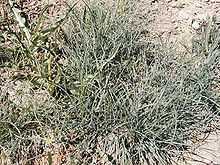Festuca idahoensis
| Festuca idahoensis | |
|---|---|
 | |
| Scientific classification | |
| Kingdom: | Plantae |
| (unranked): | Angiosperms |
| (unranked): | Monocots |
| (unranked): | Commelinids |
| Order: | Poales |
| Family: | Poaceae |
| Genus: | Festuca |
| Species: | F. idahoensis |
| Binomial name | |
| Festuca idahoensis Elmer | |
Festuca idahoensis is a species of grass known by the common names Idaho fescue and blue bunchgrass. It is native to western North America, where it is widespread and common. It can be found in many ecosystems, from shady forests to open plains grasslands.
This fescue is a densely clumping long-lived perennial bunch grass with stems from about 30 to 80 centimeters in height.[1] The stiff, short, rolling leaves are mostly located near the base of the tuft. The inflorescence has hairy spikelets which produce large awned fruits. The root system is thick and penetrates deeply into the soil. The roots have symbiotic mycorrhizae. There are no rhizomes; the plant reproduces from seeds and from budding with tillers.
This is a nutritious and preferred forage grass for wild and domestic animals. Typical native grass associates in the far west coastal prairies are Danthonia californica, Deschampsia caespitosa and Nassella pulchra.[2]
Cultivars, such as "Siskiyou Blue," are produced in the horticulture industry for landscape design and garden use.[3]
See also
- California coastal prairie
- Native grasses of California
References
- ↑ Jepson Manual. 1993
- ↑ C. Michael Hogan. 2009
- ↑ "Grasses and Grasslike plants_Acorus gramineus_Native Sons".
Notes
- C. Michael Hogan. 2009. "Purple Needlegrass (Nassella pulchra)" Globaltwitcher.com, ed. N. Stromberg
- Jepson Manual. 1993. Jepson Manual Treatment: Festuca idahoensis
External links
| Wikimedia Commons has media related to Festuca idahoensis. |
- Grass Manual Treatment: Festuca idahoensis
- USDA Plants Profile - Festuca idahoensis
- USFS: Ecology
- Festuca idahoensis - U.C. Photo gallery